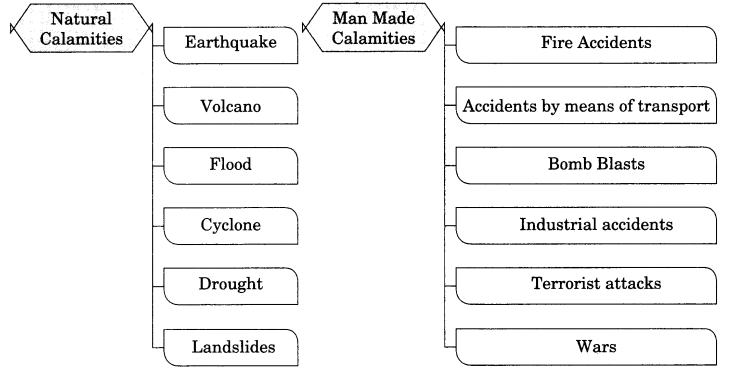Class 11 Geography Notes Chapter 7 Natural Hazards and Disasters
Disaster is an undesirable occurrence resulting from forces that are largely outside human control, strikes quickly with little or no warning, which causes or threatens serious disruption of life and property including death and injury to a large number of people, and requires therefore, mobilisation of efforts in excess of that which are normally provided by statutory emergency services.
Change is the law of nature. It is a process present everywhere with variations in terms of magnitude, intensity and scale. Change can be as sudden and swift as volcanic eruptions, tsunamis, earthquakes and lightening, etc.
Disasters are also caused by some human activities. There are some activities carried by human beings that are directly responsible for disasters. Bhopal Gas tragedy, Chernobyl nuclear disaster, wars, release of CFCs (Chlorofluorocarbons) and increase of green house gases, environmental pollutions like noise, air, water and soil are some of the examples.
Establishment of National Institute of Disaster Management, India, Earth Summit at Rio de Janeiro, Brazil, 1993 and the World Conference on Disaster Management in May 1994 at Yokohama, Japan, etc. are some of the concrete steps towards disaster management initiated at different levels.

Geological Survey of India, Department of Meteorology, Government of India, along with the recently formed National Institute of Disaster Management, have divided India into the following five earthquake zones:
(i) Very high damage risk zone
(ii) High damage risk zone
(,iii) Moderate damage risk zone
(iv) Low damage risk zone
(v) Very low damage risk zone.

Disaster Management issue was raised at the U.N. General Assembly in 1989 and it was finally formalised at the World Conference on Disaster Management in May 1994 at Yokohama, Japan. This was subsequently called the Yokohama Strategy and Plan of Action for a Safer World.
Cyclones originate between 10°-15° north latitudes during the monsoon season. In Bay of Bengal, cyclones mostly develop during the months of October and November. Here, they originate between 16°-2° N latitudes and to the west of 92° E. By July, the place of origin of these storms shifts to around 18° N latitude and west of 90°E near the Sunderban Delta.
Floods occur commonly when water in the form of surface run-off exceeds the carrying capacity of the river channels and streams and flows into the neighbouring low-lying flood plains.
Various states of India face heavy loss of lives and property due to recurrent floods. Rashtriya Barh Ayog (National Flood Commission) identified 40 million hectares of land as flood-prone in India.
According to some estimates, nearly 19 per cent of the total geographical area of the country and 12 per cent of its total population suffer due to drought every year. About 30 per cent of the country’s total area is identified as drought prone affecting around 50 million people.
On the basis of severity of droughts, India can be divided into the following regions:
(i) Extreme Drought Affected Areas
(ii) Severe Drought Prone Area
(Hi) Moderate Drought Affected Area
Different natural calamities, their causes and measures to reduce their impact




Class 11 Geography Notes Chapter 7 Important Terms:
- Disaster: Disaster is an undesirable occurrence resulting from forces that are largely outside human control, strikes quickly with little or no warning, which causes or threatens serious disruption of life and property including death and injury to a large number of people, and requires therefore, mobilisation of efforts in excess of that which are normally provided by statutory emergency services.
- Natural hazards: Natural Hazards are elements of circumstances in the natural environment that have the potential to cause harm to people or property or both.
- Drought: The term ‘drought’ is applied to an extended period when there is a shortage of water availability due to inadequate precipitation, excessive rate of evaporation and over¬utilisation of water from the reservoirs and other storages, including the ground water.
- Landslide: A form of mass movement in which rock and debris moves rapidly downslope under the influence of gravity as a result of failure along a shear plane.
- Tsunamis: Earthquakes and volcanic eruptions that cause the sea-floor to move abruptly resulting in sudden displacement of ocean water in the form of high vertical waves are called tsunamis (harbour waves) or seismic sea waves.
- Flood: When a river bursts its banks and the water spills out onto the floodplain, it is called flood.
- Meteorological drought: When there is a prolonged period of inadequate rainfall marked with mal-distribution of the same over time and space, it is called meterological drought.
- Agricultural drought: When there is by low soil moisture that is necessary to support the crops, thereby resulting in crop failures, it is called agricultural drought.
- A tropical cyclone or hurricane: It is like a heat engine that is energised by the release of latent heat on account of the condensation of moisture that the wind gathers after moving over the oceans and seas.
- Hydrological drought: It results when the availability of water in different storages and reservoirs like aquifers, lakes, reservoirs, etc. falls below what the precipitation can replenish.
- Ecological drought: When the productivity of a natural ecosystem fails due to shortage of water and as a consequence of ecological distress, damages are induced in the ecosystem. It is called ecological drought.
- Eye of the storm: The centre of the cyclone is mostly a warm and low-pressure, cloudless core. It is known as eye of the storm.
- Storm Surge: Abnormal rise in the sea level is known as Storm Surge.
- Famine: Extreme scarcity of food as a result of drought is called famine.
- Earthquake: An earthquake (also known as a quake, tremor or temblor) is the result of a sudden release of energy in the Earth’s crust that creates seismic waves.
- Seismicity: The seismicity, seismism or seismic activity of an area refers to the frequency, type and size of earthquakes experienced over a period of time.